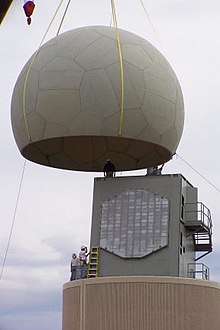Multifunction Phased Array Radar
 MPAR being installed in 2003. | |
| Country of origin | USA |
|---|---|
| Introduced | 2003 |
| No. built | 1 |
| Type | Weather/Air-traffic radar |
| Frequency | 3,200 MHz (S band) |
| PRF | 918 Hz |
| Beamwidth | broadside 1.6° - 2.2° at 45°[1] |
| Pulsewidth | Adjustable to 2.5 μs |
| RPM | Mechanically steered |
| Altitude | 360 m (1,180 ft) |
| Diameter | 3.7 m (12 ft) |
| Azimuth | Mechanically steered - 4+ antennas anticipated with operational deployment |
| Elevation | up to 60º |
| Power | 750 kW |
Multifunction Phased Array Radar is an experimental radar system that is derived in Phased Array technology. Conceptually, MPAR can scan at angles as high as 60 degrees in elevation, and simultaneously track meteorological phenomena, biological flyers, non-cooperative aircraft, and air traffic. Throughout the next decade, NOAA plans to gradually decommission their TDWR and NEXRAD systems in favor of several hundred dual-pol MPARs.[2] As of 2017, there is one operational MPAR within the mainland United States - a decommissioned AN/SPY-1 radar antenna donated to NOAA in 2003 by the U.S. Navy.
History
The radar the antenna is derived from, a U.S. Navy AN/SPY-1, which first saw service beginning in 1973, was installed on the USS Norton Sound 10 years after it was designed. During its engagement, it was noticed that the false-alarm rate was high due to the radar detecting swarms of insects and nearby mountainous terrain.[3] Although problematic for mitigation of threats nearby, this proved vital for Phased Array as a candidate in the meteorological spectrum. As time progressed and different variations of the AN/SPY family arose through the 90s, in 2003 the U.S. Navy donated one functional MPAR antenna to NOAA for meteorological research. Once donated, NOAA built a small tower and pedestal in Norman, Oklahoma to house the antenna and its components.[4]
Deployment and uses

From 2003 to 2016, the MPAR located in Norman was used as a Proof-of-concept test that helped lead to much faster volume scans, and more complete insights to supercellular structure. Due to the time resolution ranging from 30 to 60 seconds and the one-sector scanning solution MPAR practices, lead time also increased as much as 8 minutes from the already existing 13 minutes.[5] One problem is the polarization - that is, the polar orientation of the beam within the Phased Array. In recent years, dual-polarization in the horizontal and vertical poles have been put to use in the NEXRAD system, which operates with axial-fed parabolic antennas. However, since the MPAR antenna is not in this configuration, dual-polarization is still an experimental concept and has yet to be tested on a large scale. This is due to the fact the AN/SPY series was designed in the mid-1970s - retrofitting this technology would prove much too costly if not impossible. [6] MIT is heading the project of dual-pol MPAR, and a prototype is likely to be installed in Norman within the next 3 years on a non-operational basis.[7] Besides meteorological observation, the FAA also is likely to phase out their current system of ASR/TDWRs in favor of MPAR. While mainly for meteorological uses for local NWS WFOs, MPAR is conceptually built as an air-monitoring radar. This being so, it can constantly scan in specific sectors for aircraft, biological clutter, and wind shear at most elevations.[8]
References
- ↑ https://journals.ametsoc.org/doi/pdf/10.1175/JTECH-D-15-0018.1
- ↑ "Research Tools:Multi-Function Phased Array Radar". nssl.noaa.gov. Retrieved 2017-09-26.
- ↑ Friedman, N. (2006). The Naval Institute Guide to World Naval Weapon Systems. Naval Institute Press. p. 316. ISBN 9781557502629. Retrieved 2017-09-26.
- ↑ https://www.nssl.noaa.gov/about/.../Hondl_NSSLReview2015_MPAR_Overview.pdf
- ↑ John Cho and Sean Duffy (2011-07-28). "Multifunction Phased Array Radar (MPAR)" (PDF). Retrieved 2017-09-26.
- ↑ Jerry Crain (2006-11-01). "Polarization for Phased Array Weather Radar" (PDF). Retrieved 2017-09-26.
- ↑ "MIT Lincoln Laboratory: FAA Weather Systems: MPAR". www.ll.mit.edu. Retrieved 2017-09-26.
- ↑ "faaco.faa.gov/index.cfm/attachment/download/26709". faaco.faa.gov. Retrieved 2017-09-26.